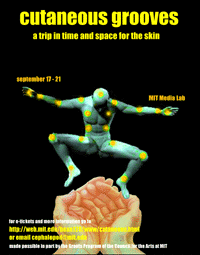Designer/Composer/Programmer
Glorianna Davenport
The skin is by far the largest organ in the body, covering about 18,000 cm2 in the average male adult, constituting about 16-18 percent of total body weight. Touch is considered by many to be the most important of our senses, for without it we can have no sense of the physical boundaries of our own bodies or our surrounding physical environment. The sense of touch is indispensable for the creation of all kinds of artistic artifacts. Why then, do we generally deny our skin the oppportunity to *behold* artistic expression?
A number of factors, including technological limitations, have inhibited the exploitation of our sense of touch as a compositional medium. Psychophysical research on the sense of touch has demonstrated that as a receiving instrument the skin combines the best abilities of the eye and the ear, exhibiting high acuity in both space and time. Harnessing existing "tactile stimulation" technology, we can begin to explore the sense of touch as a channel for aesthetic composition, moving one small step closer to the Feelies of Huxley's "Brave New World".
Cutaneous Grooves was a showcase of the idea of "tactile composition." It was essentially a concert for the skin; a dance that you feel instead of see. A space was set up for ten people with an individual vibrotactile stimulation device for each audience member. During the show the audience would experience choreographed vibrations against the surface of the body. Most of the pieces were accompanied by music while some were exclusively tactile. The following video footage illustrates the space and several audience members suiting up at the beginning of the concert. Stay tuned for a more comprehensive video of the show.
Research Supervisor
![]()
![]()
Gunther E (2001).
Skinscape: A Tool for Composition in the Tactile Modality
MIT MSEE Thesis, 2001.
